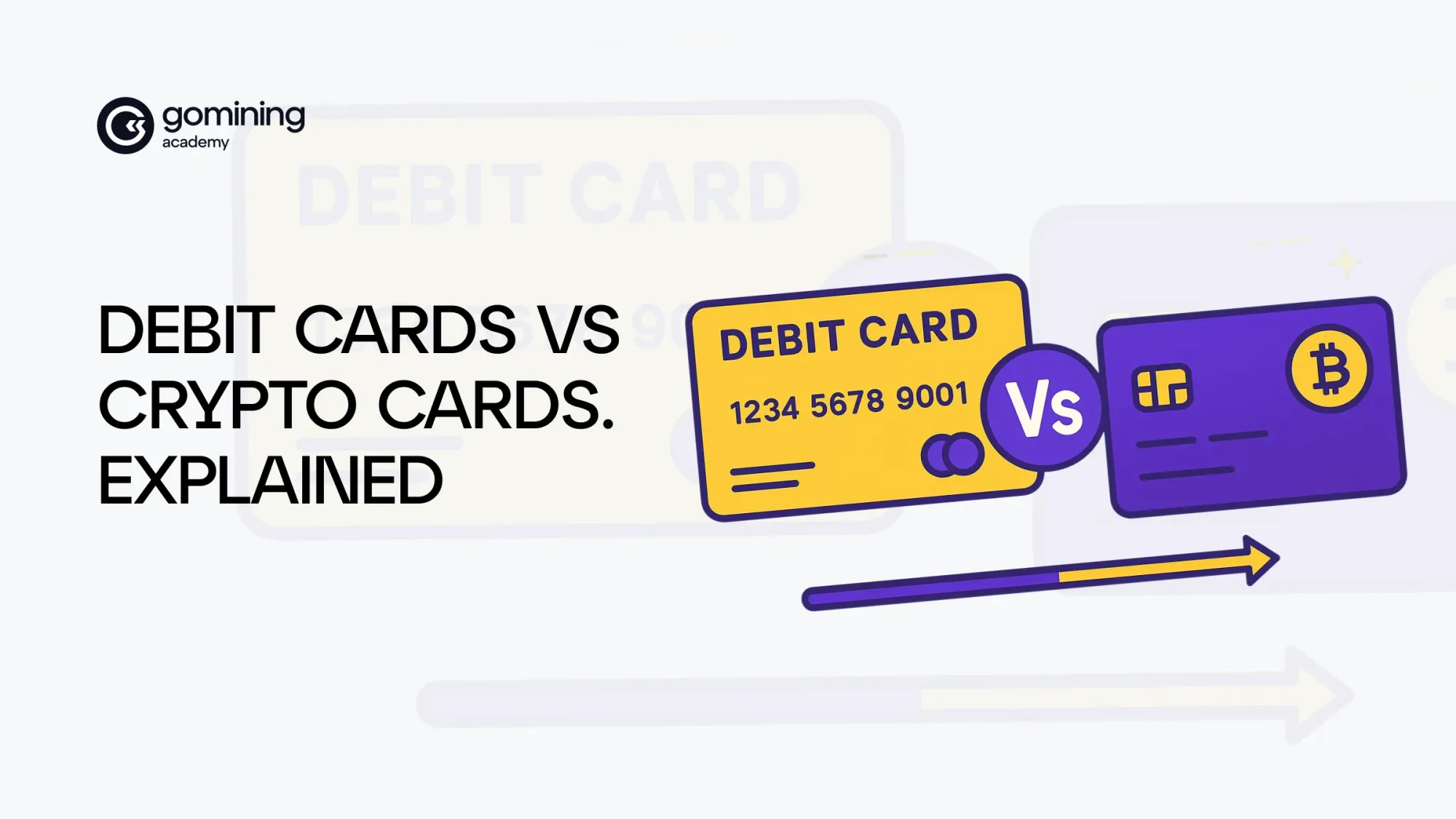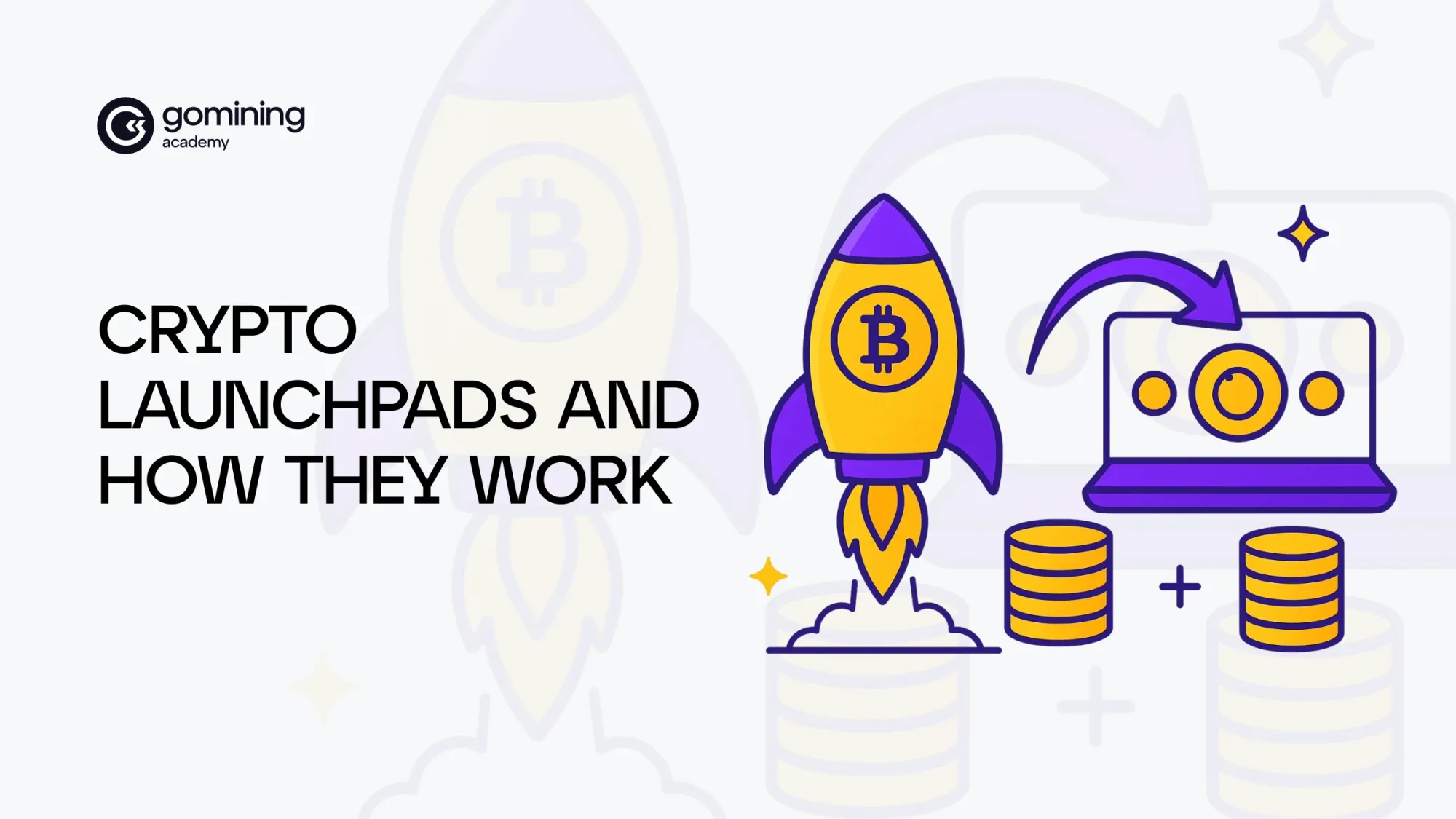What Is Web3? A Simple Guide to the Future of the Internet
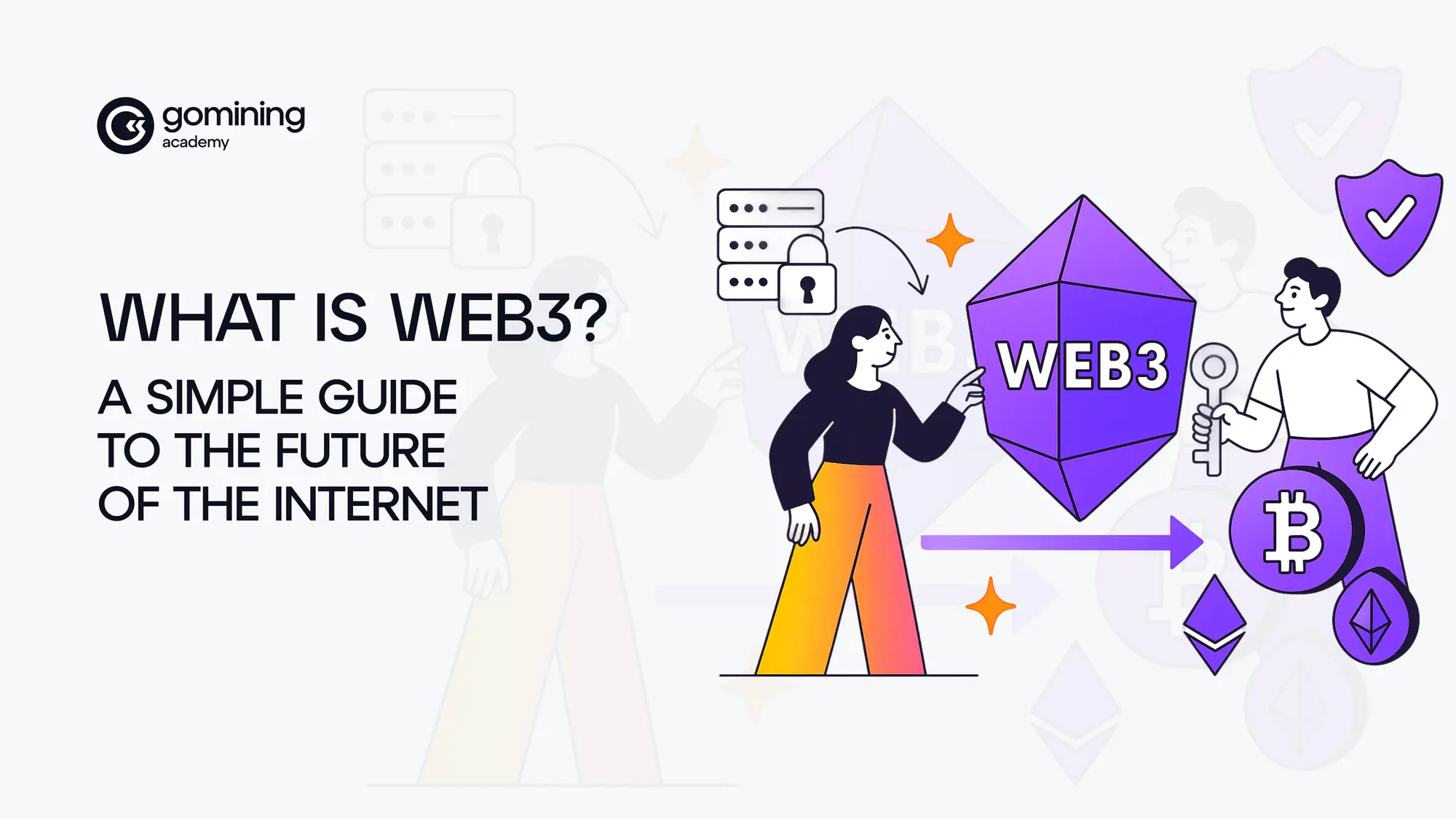
Tired of the Internet treating you like a product instead of a person? When every like, swipe, and click is like feeding the data beasts that crawl around the web.
But is it even possible to own your data anymore? You have probably heard of Web3 on your X/Twitter feed, and feel none the wiser.
What is Web3? Is it a new app? A cult? A secret club where everyone talks in acronyms and trades monkey JPEGs for millions? Not quite (though… maybe a little). At its core, Web3 is a reimagined version of the Internet built on blockchain—a techy-sounding word that simply means “a public, uncheatable ledger that doesn’t need a boss.”
Instead of trusting giant companies to run the show, Web3 lets communities, code, and cryptography do the heavy lifting. It’s the upgrade we didn’t know we desperately needed— but with way fewer passwords and a lot more power in your hands. At its core, a Web3 blockchain is an open, auditable ledger that anyone can build on—no corporate gatekeepers, just code and community.
Table of contents
- Origin Story: Web1, Web2, and Finally Web3
- Web2 vs Web3: The Internet Glow-Up
- Smart Contracts: The Code That Runs Web3 (And Doesn’t Ghost You)
- What is a Web3 Wallet? It’s Your Key, Your Identity, Without the Passport Information
- Coins, NFTs & Tokens: The Currency, Collectibles & Utility of Web3
- Web3 Isn’t Just Hype—It’s dApps
- Quick Checklist for Web3 Beginners
Origin Story: Web1, Web2, and Finally Web3
👵 Meet Grandma Web1: The Internet’s Stoic, Static Matriarch
Before the likes, the swipes, and the endless scroll, there was Web1—the OG Internet. Web1 was basically a giant digital library—read-only, no talking back. You browsed static pages, read news, maybe checked the weather if you were feeling fancy. It was a simpler time... and also, let’s be honest, kind of a snoozefest.
But we respect her. Grandma Web1 didn’t ask for your data. She didn’t try to monetize your existence. She gave us the building blocks—HTML, hyperlinks, and that iconic “under construction” GIF. Web1 laid the foundation. Web2 built the house. And Web3? Web3 is throwing out the landlord and handing you the deed.
Breaking Up With Web2
Let’s be real—Web2 had a good run, but it’s starting to feel like that clingy ex who knows way too much about you and sells your secrets for ad money. From social media giants that farm your data to platforms that can vanish your account without warning, the Web2 era turned “free” services into surveillance playgrounds.
You create the content, but guess who cashes the checks? (Hint: not you.) And those shiny apps you use every day? Most are black boxes run by invisible middlemen—gatekeeping, censoring, and tracking your every move like a nosy landlord with a master key. It’s efficient, sure. But empowering? Not so much.
Enter Web3: Not a Savior, But a Decent Upgrade
Web3 isn’t some messianic codebase floating down from the cloud with angelic bandwidth. But it is a serious glow-up. Instead of trusting corporations with your data, your identity, and your online soul, Web3 hands you the keys to your own digital kingdom. Imagine apps that run without owners, currencies without banks, and communities without gatekeepers. That’s the Web3 vibe.
🌐 Web2 vs Web3: The Internet Glow-Up
If Web2 is renting space on someone else’s platform, Web3 is holding the keys to your own corner of the digital world. Fewer passwords. More power. And a whole lot more “what if?”
📚 Web2 vs Web3 — The Library vs. The Book Club
Web2 is like a public library
You can browse, read, maybe scribble some comments in the margins (likes, posts, shares). But at the end of the day, the librarians—aka Big Tech—decide what stays, what gets censored, and who’s allowed in the building. Oh, and they’re definitely watching what you read.
Web3? It’s more like a book club with no gatekeepers.
Everyone has a copy of the book. Everyone can see the story unfold (hello, transparency). No one can sneak in and rewrite the ending without the whole club knowing (that’s immutability). And if a new book needs to be added? The group votes.
Even better—you keep your own copy. It’s yours. Not borrowed. Not tracked. Not deleted on a whim.
Is it perfect? Not really – but in a world where digital freedom often comes with fine print, Web3 hands you the keys and says: write your own chapter.
Smart Contracts: The Code That Runs Web3 Technologies
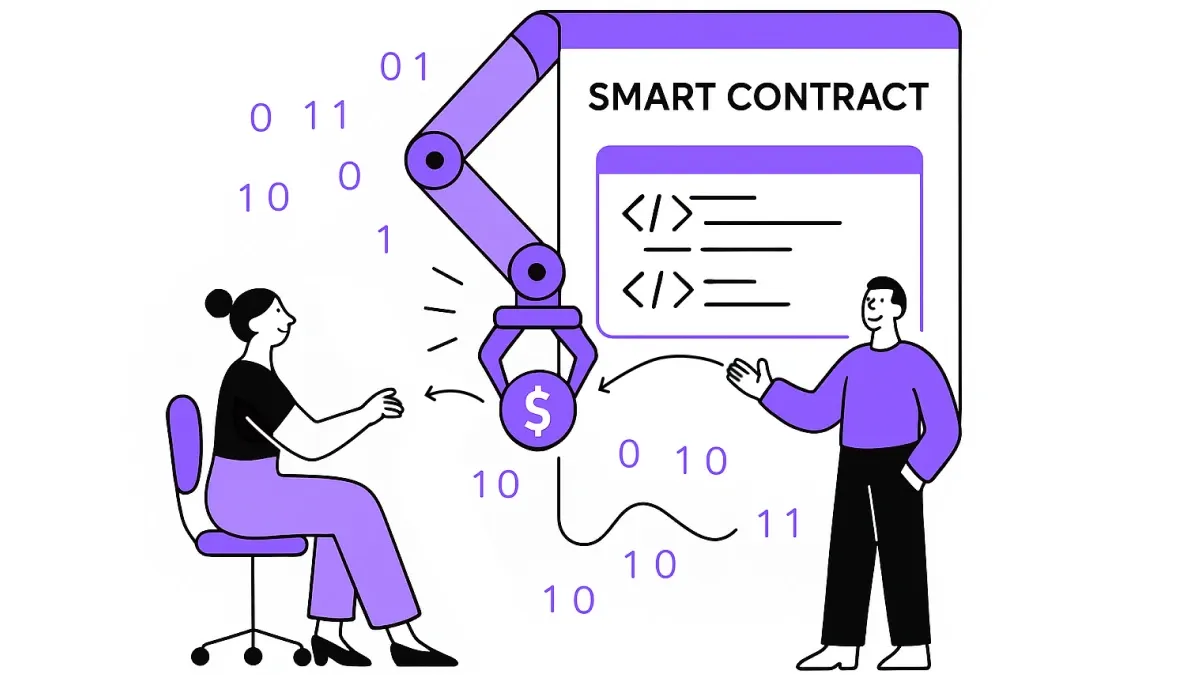
Imagine if apps like Uber or Airbnb didn’t need companies to operate. No middlemen, no 3 a.m. customer service robots, just code. That’s the idea behind smart contracts: programs that live on the blockchain and run exactly as written. In Web3, you click a button, and the blockchain executes the code on it automatically. It’s like doing business with a vending machine: no small talk, no mistakes—just input and exact output. Smart contracts are the quiet backbone of the Web3 revolution. They replace the need for “trust” with verifiable action. Here’s what makes smart contracts so powerful:
- No trust needed: The code doesn’t lie, and once deployed, it can’t be changed on a whim.
- Global coordination: People around the world can interact, exchange value, or collaborate without knowing each other—just by interacting with a shared contract.
- Infinite use cases: From lending protocols and NFT marketplaces to voting systems and virtual real estate, smart contracts power it all.
What is a Web3 Wallet? It’s Your Key, Your Identity, Without the Passport Information
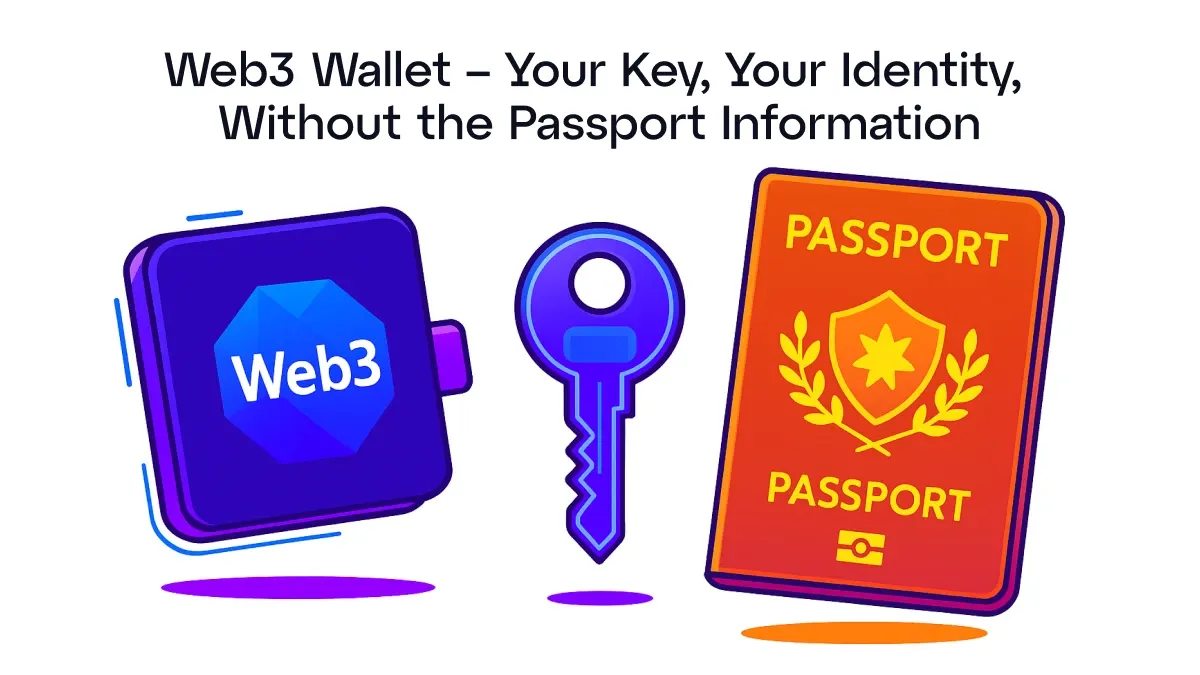
Your first stop on the journey into the Web3 crypto universe is getting yourself a crypto wallet. It’s your passport, your ticket, your all-access backstage pass to the decentralized universe.
In Web2, every website feels like crossing into a new country—you flash your passport (aka login credentials) at every border. But in Web3? One wallet is all you need. It’s a universal passport that lets you roam across web3 without stamping your identity on every doorstep.
Forget the endless parade of sign-up forms, password resets, and “Please verify your email” rituals. In Web3, your wallet is your ID. And the best part? You decide what info to share at each border (because let’s be real—you wouldn’t tell the arcade your home address).
- No usernames, no passwords: Your wallet address—like 0xSuperCoolCryptoHuman—is your identity.
- No data farming: DApps don’t need your email to function. You’re not the product anymore—you’re the participant.
- Instant access: Just click “Connect Wallet” and boom, you're inside the ecosystem. Whether you want to mint an NFT, lend some crypto, or buy a dragon skin (which is also a financial asset)—you’re good to go.
Coins, NFTs & Tokens: The Currency, Collectibles & Utility of Web3
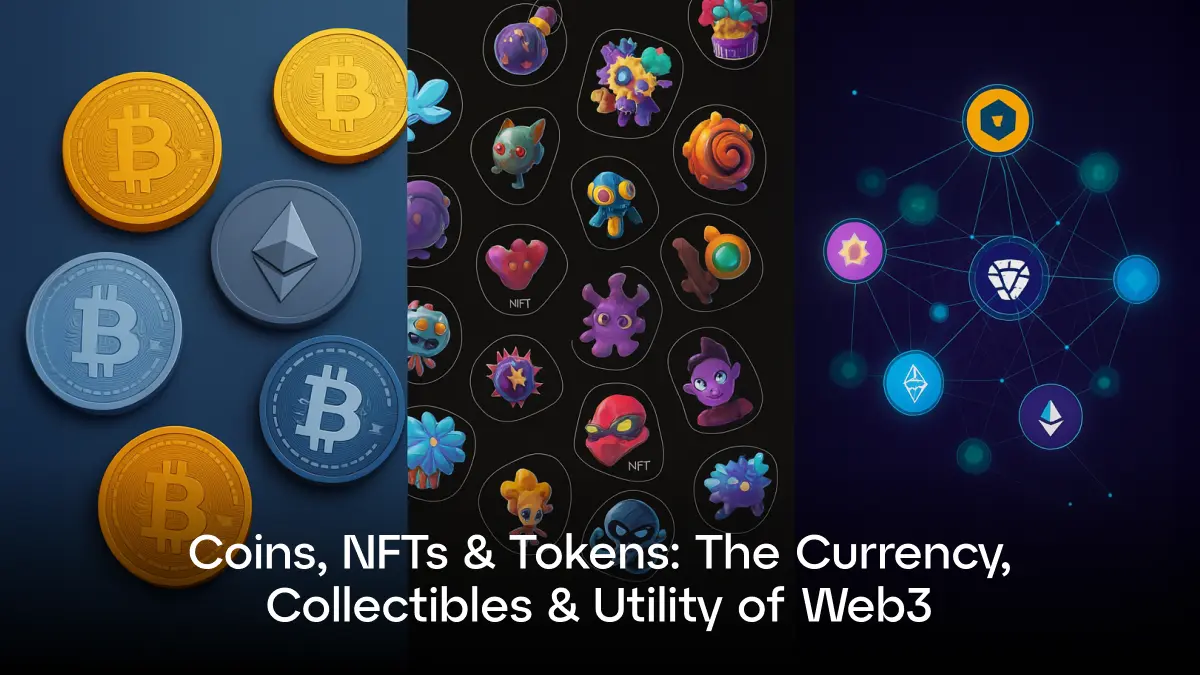
Web2 ran on old-school fiat payment systems—credit cards, banks, and all the middlemen in between. But Web3 plays a whole different game. It runs on a brand-new financial layer built right into the blockchain. So what will you actually use in this new world? Spoiler: it’s not dollars… and it’s definitely not dog photos. It’s crypto coins and NFTs—the fuel and flair that keep the Web3 engine humming.
🧠 Fungible? It’s Really Just About Swapping Stuff
Fungible means interchangeable. Like money. One dollar is the same as any other dollar. No one’s going to say, “Wait, not that one!” If I owe you $5, you don’t care which $5 bill I give you—any one will do. That’s fungibility in action.
But then there's non-fungible—and that’s where things get personal.
Non-fungible means one-of-a-kind. Unique. Irreplaceable. Like:
- 🎨 A painting you made that’s 40% genius, 60% chaos
- 🎟️ A concert ticket with your seat and your name
- 📸 … that embarrassing school photo your mom keeps framed on her desk. The one with your uneven haircut and the haunted smile. You can’t just swap that with someone else’s photo and call it even. It’s yours. That’s the spirit of non-fungible.
🪙 Coins = Your Digital Money
In Web3, coins are your currency. Whether you’re sending money to a friend, paying for something in a dApp, or covering transaction fees, coins are how you move value around. They’re fungible tokens — which just means one coin is the same as any other, like digital cash.
- Need to pay? You’ll need coins.
- Want to get paid? Yep — coins again.
Everything from tipping a creator to funding a project happens with these digital dollars.
🎨 NFTs = Your Digital Stuff (non-fungible)
Now for the flair. NFTs (Non-Fungible Tokens) are the unique digital assets that Web3 lets you actually own. Each one is a verifiable “one of one”—like a trading card, ticket, artwork, game item, or even a digital flex. In the context of dApps:
- Buy a skin in a Web3 game? It’s an NFT, and you can sell it later.
- Attend a virtual event? Your ticket might be an NFT that proves you were there.
- In Web3, an NFT can act like a digital badge that proves you belong to a certain group—kind of like flashing a VIP card at the velvet rope of a very online club.
🧩 Tokens = The Utility Layer Between
Tokens live in the space between coins and NFTs. They’re typically fungible like coins, but they carry purpose like NFTs. Tokens can give you access, voting rights, rewards, or in-app utility—without necessarily representing a collectible or currency.
Think of them as:
- 🗳️ Governance tools Some tokens give you voting power in Web3 apps. Imagine a global co-op where decisions are made by token holders, directly on the blockchain, instead of shareholders. You can help vote on upgrades, policy changes, or how the project spends its funds.
- 🛠️Utility Passes. Think of them like VIP passes: holding one can unlock special features, content, or privileges that regular users don’t get on certain blockchain apps. Sometimes it's early access, bonus tools, or premium experiences... all stored neatly in your wallet.
- 🧃 Reward systems Tokens are also used to reward users on blockchain applications depending on how they participate on them.
There is a whole universe in the crypto cosmos called tokenomics. Tokens are the connective tissue of Web3. Not quite money. Not quite memorabilia. But absolutely essential for doing cool stuff. While coins are like dollars, NFTs are like collectibles or deeds—things you own, trade, or show off. Tokens create

💥 The Economic Trifecta of Web3
So while crypto coins are the fuel, tokens are the gears, and NFTs are the flare—together, they form the economic heartbeat of Web3.
- Coins move you through the system
- Tokens let you participate, govern, and unlock
- NFTs define what you own and flex
And the best part? You control the value, the creativity, and the keys to it all.
🧩 Web3 Isn’t Just Hype—It’s dApps
Welcome to the world of dApps—short for decentralized applications—the places where all the Web3 action happens. Instead of apps, dApps run on blockchains, are powered by smart contracts, and connect directly with your Web3 wallet. It’s like using familiar apps, but instead of being monitored by Big Tech, you stay in control—and sometimes even get rewarded just for showing up.
Web3 Examples of dApps
🏦Decentralized Finance (DeFi)
Examples: Uniswap, Aave, Compound
Think of DeFi apps as financial tools without the bank. You can trade tokens, earn interest, or borrow crypto—all without signing a single form or talking to a human in a suit. How is this possible? The answer are liquidity pools
- Want to swap ETH for another token? Use Uniswap.
- Want to lend out your tokens and earn passive income? Try Aave or Compound.
- No credit checks, no banks—just you, your wallet, and smart contracts doing all the heavy lifting.
Each of these projects runs on a Web3 platform such as Ethereum, Solana, or Base, where smart contracts replace the old-school “sign-up and sign-away-your-data” model.
🎮 Gaming dApps
Examples: Illuvium (Illuvium, the world's first IBG (Interoperable Blockchain Game)
These are video games powered by blockchain, where you actually own what you earn.
- That sword you fought for? It’s an NFT—you can sell it.
- That character you leveled up? It’s yours, and might even increase in value.
- Instead of just playing for fun, you’re playing for potential rewards—some even earn real crypto while gaming.
In Web2, your in-game items stay locked in someone else’s servers. In Web3? You take them with you.
🎨 NFT Marketplaces
These are like digital art galleries and collector’s shops rolled into one, but built on blockchain.
- Want to buy art, music, or collectibles that live online but are provably yours? You’ll find them here.
- Want to mint (i.e., create) your own NFT and sell it? Also here.
- It’s where artists, collectors, and curious first-timers mingle—and your wallet is your all-access pass.
You’re not just downloading an image—you’re owning a piece of blockchain-backed history.
🗳️ DAO Platforms (Decentralized Autonomous Organizations)
DAOs are like online communities with shared bank accounts and no bosses. These platforms let Web3 users govern platforms, build projects, and fund ideas together, all without needing to trust a central authority. Everything is run by members who vote on proposals using tokens—and everything is transparent, thanks to smart contracts.
- Want to help decide how a project spends its money? Vote through a DAO.
- Want to fund a creative idea, community event, or even a meme project? DAOs like Juicebox make that happen.
- No CEOs, no middle managers—just code and collective decision-making
Real-World Web3 Companies Making Noise
Each of the following companies show how ownership and governance flip when you build on-chain instead of on servers.
• ConsenSys (MetaMask)
• OpenSea • Uniswap Labs
• Animoca Brands
• Worldcoin
Every time you fire up a dApp—whether you’re buying an NFT, borrowing crypto, or voting in a DAO—you authorize the move with your wallet. No middleman, no paperwork. Just you, the code, and a dash of digital swagger.
Web2 Apps vs dApps
dApps are where Web3 actually happens. They’re the blockchain’s answer to websites and platforms—but this time, you’re not the product. You’re the power. 🔑
- You connect with your wallet, not a username and password
- You own your in-app items (like NFTs, not just temporary cosmetics)
- You can earn actual crypto, not just fake internet points
- You can help shape the platform—some dApps let you vote on how they evolve through governance tokens
GoMining: How Web3 Tokenizes Real-World Bitcoin Mining with NFTs & Rewards
GoMining isn’t fully decentralized, but it uses blockchain technology, NFTs, and token rewards to let anyone access real-world Bitcoin mining on-chain—showcasing how Web3 tools can bridge physical and digital economies. GoMining offers people the opportunity to get involved in Bitcoin mining.
Bitcoin mining is an alternative to directly purchasing Bitcoin, and allows you to participate in Bitcoin’s ecosystem. Is Bitcoin mining profitable? There are many factors to consider, such as being able to invest in serious Bitcoin mining hardware.
GoMining lets you skip the loud hardware and jump straight to earning BTC with a low-cost Digital Miners as NFTs. It is crypto mining done online. Each NFT is tied 1-for-1 to real ASIC hash-power in GoMining’s data centres; once minted inside GoMining's crypto mining app, it starts producing Bitcoin immediately.
Need to see the numbers first? Plug your hash-rate into their crypto profit calculator and explore themed NFT on GoMining digital miner collections such as Space or CyberPunk.
The platform’s economy revolves around the utility GOMINING token. Paying maintenance fees with it earns up to a 20 % discount, and the weekly burn-and-mint schedule detailed in the project’s tokenomics steadily reduces supply.
For bigger boosts you can stake tokens to unlock the GoMining vip loyalty program that shave extra costs and add cosmetic upgrades.
Gamified layers keep users coming back. In their GoMining web3 game, titled Miner Wars, which is a holders pool hash-power to compete for bonus BTC. Choose from an array of GoMining digital avatars and unlock the new universe of GoMining and Bitcoin.
✅ Quick Checklist for Web3 Beginners
Use a trusted exchange and wallet
Start with big-name, beginner-friendly exchanges like Coinbase, Kraken, or Binance. For wallets, go with something like MetaMask, Trust Wallet, or a hardware wallet if you're serious. Avoid sketchy apps from random Telegram links.
Back up your wallet’s recovery phrase offline
Your seed phrase is your one-shot master key. Write it down on paper (not in your Notes app!) and store it somewhere safe. No one—not even the wallet company—can help you recover it if it’s lost.
Beware of scams and phishing
If someone DMs you offering free tokens or “urgent” help, it’s a trap. Always triple-check links, especially when connecting your wallet. And never, ever give your seed phrase to anyone.
Invest only what you can afford to lose
Crypto can swing wilder than a caffeinated squirrel. Don’t put your rent money into NFTs or go all-in on “the next Ethereum.” Start small, learn the ropes, and breathe.
Set a strategy and stick to it
Whether you're dollar-cost averaging, HODLing, or flipping NFTs, make a plan. Emotional trading is how wallets get drained and dreams get wrecked.
Stay updated with reliable news
Follow trusted sources like CoinDesk, Bankless, or The Defiant. Avoid the pump-n-dump echo chambers. Twitter alpha is great—but only if you know who to trust.
Interact with dApps carefully
Always check the site URL. Don’t blindly click “Approve.” Understand what the smart contract is asking for. If you're unsure, walk away—or ask a trusted community before confirming anything.
Understand local regulations and taxes
Depending on where you live, crypto gains might be taxable, and some tokens may be considered securities. Know your legal landscape to avoid surprise love letters from the tax office.
🌐 Congratulations, You’ve Unlocked: “Web3 Literacy:Level 1”
Web3 isn’t just some tech bro fever dream or crypto buzzword cocktail. It’s a legit shift in how we connect, create, trade, and own online. Like everything in its infancy, it’s messy, thrilling, imperfect—but it’s ours. Built on smart contracts, powered by tokens, and accessed with wallets instead of passwords, Web3 puts you in the center of the action.
Ready to take the leap? Go ahead—download that wallet, poke around a dApp, buy an NFT that makes your friends roll their eyes. Get messy, get weird, get wonderfully Web3. So start small. Stay curious. Read what you sign. And never forget: you’re not late to web3. You’re right on time.
And if you learned something here, share this article with a curious friend, an unsuspecting normie, or that one guy still hoarding Dogecoin on Robinhood. Let’s drag them into the future with us—wallet-first, sass-second.
Because Web3 isn’t waiting. It’s just warming up. 🔥🔐

